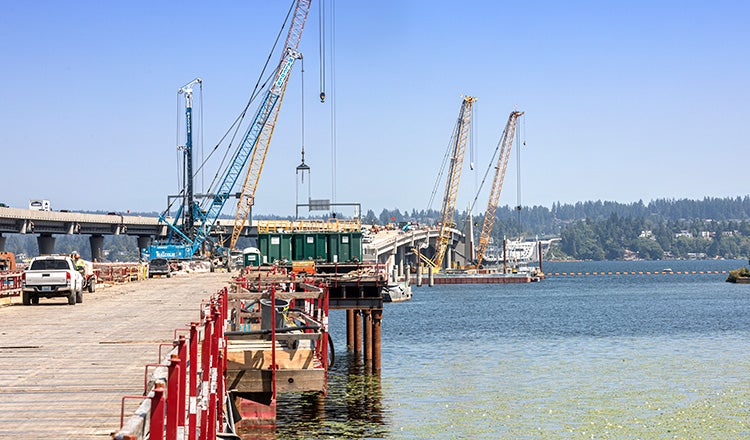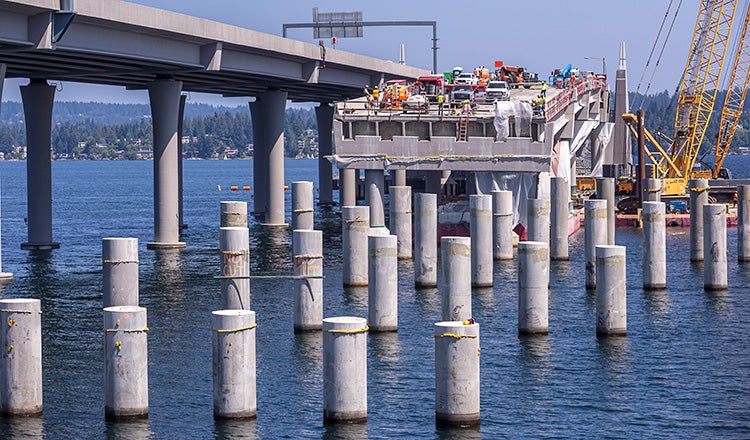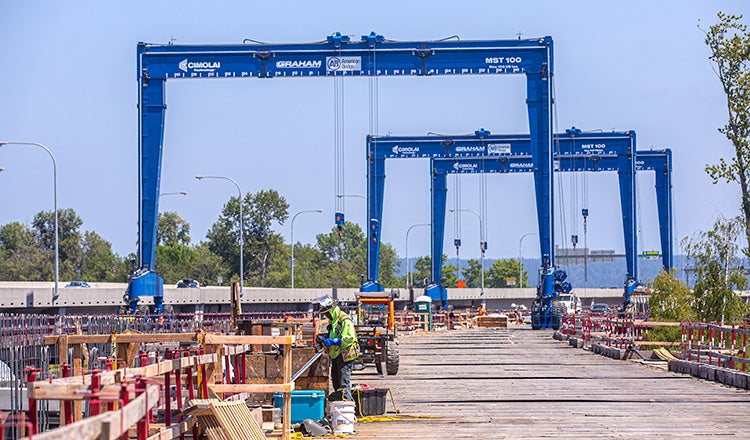
Experts Talk: Construction Management on Major Transportation Programs with Tom Horkan
Experts Talk is an interview series with technical leaders from across our transportation program.
Keeping Complex Infrastructure Programs on Schedule and Budget with Construction Managers
Large-scale transportation programs can be dizzyingly complex, with dozens of individual but interconnected projects, many contractors and subcontractors, and third parties with different goals. Effectively managing the construction process on these programs is critical to keeping projects on schedule and within expected budgets.

Tom Horkan, P.E., has decades of experience working on complex transportation programs as a program manager, construction manager and procurement lead. He has held key leadership roles on major transportation programs across North America, ranging from $800 million to $4.5 billion. He served as construction director on the world’s longest floating bridge, the SR 520 bridge replacement in Washington. Throughout his career, Horkan has worked closely with public sector owners and program leadership in integrated project offices, handling broad responsibilities from conception to operation. In this interview, he explains how a strong construction management approach can mitigate risk, support program goals and provide effective on-site advocates for owners.
Q. How do program management and construction management fit together?
A. The two roles are intricately connected and can fill similar functions, but the specific roles depend heavily on each program and its needs. In general, construction management is focused on construction delivery and helping infrastructure owners manage their construction contracts. That can involve strategic advice and procurement advice before construction begins and last through the construction of projects, with inspection, project controls, administration work, claims assistance and more.
Program managers, on the other hand, oversee an entire program, often made up of many individual construction contracts, from planning through environmental review through design through construction. Both roles rely heavily on risk management processes and take a holistic look at a program. Often, clients combine these roles and hire a PM/CM to make sure that program managers are involved all the way through completion of construction.
Specific names for these roles can vary, and construction management services could be provided as a general engineering consultant, an owner’s representative or under a program management umbrella. The key is that construction management involves ensuring that construction contracts are followed.

Q. How can owners improve the success of construction management relationships?
A. The most successful construction management relationships are when the construction manager is involved in the big picture delivery as opposed to specific tasks. Sometimes clients who are hiring a program manager or construction manager for the first time become very anxious about the details of scope, how the scope is worded and what the specific roles are. We always tell our clients that we're here to help. Our interest is in your long-term success, not in a short-term fee.
Construction management programs that I have seen to be the most successful are those where owners apply our strategic advice and involve senior staff in their decision making, giving them the benefit of knowledgeable experts who’ve done this work across the continent using varying approaches for decades. Culturally, this can require a conscious shift in approach, but when it works, it really works well.
Q. If the program is using an alternative delivery approach, why does it still need a construction manager?
A. I think alternative delivery projects are often where owners need an experienced construction manager the most. Because of the complexity of the contracts and the varying approach to managing the construction contracts, having a dedicated and experienced construction manager can be critical to avoid unexpected problems.
Alternative delivery methods can be great options, and can offer an owner less risk, but that depends on the contract being managed effectively. The ultimate delivery of any project is through a construction contract. And yes, that contract may shift more risk to the contractor. However, it requires a lot of expertise to make sure that that risk stays with the contractor as you're managing construction. Some of that requires making sure the procurement documents and contracts are written correctly, to provide the risk equation an owner expects. And then as construction begins, it means making sure that documentation occurs and schedules are reviewed to keep the risk the way the contract specifies. That requires a lot of diligence and a lot of expertise.
Alternative delivery methods are becoming more popular throughout the country, but they are still new to many owners. I spoke recently with a large organization that is going to try its first CM/GC contract. They don’t have anybody on staff who’s used the method before, so we’ll work side-by-side with the procurement department and their legal department, get the contracts put together, and help them navigate the procurement process. There are many owners in the same situation.
Q. How does a construction management approach help inform delivery method decisions?
A. As part of our construction management services, we often help clients choose which delivery method works best for them to meet their goals. Usually that delivery decision is done in conjunction with the preliminary design process.
Sometimes the delivery method focuses on schedule, when a program needs to meet a certain date. Those projects often gravitate toward design-build delivery. Others have very complicated constructability issues, which often leads to a CM/GC approach. For other programs, budget is the most important, overriding other considerations. In every case, managing risk is a critical decision, with owners deciding how much project risk to shift to the contractors.
We facilitate workshops, we bring in different delivery and procurement expertise, and we work with the client to determine the most appropriate delivery method for each project of their program. On large programs, this can mean using different delivery methods for different projects. Then we work with clients to make sure their goals for their program — often a key part of the reason they chose a specific delivery method in the first place — are met through final construction and delivery.

Q. How is technology advancing and changing construction management?
A. Technology offers us real-time information on the status of projects, keeping us more up to date than ever.
When I began in construction management more than 30 years ago, we would wait for days or weeks for an update. These days, our ability to coordinate and get construction issues resolved in the field is light years ahead. Our field inspectors’ tools send and receive information from the cloud and provide real-time project information to our project control systems. Cameras and video conferencing can let us see work even if we’re not physically at the site. On the management side, building information modelling, or BIM, is a big part of reducing construction conflicts. And dashboards let us see at a glance the status of our projects, where we’re behind and what needs attention now. Armed with better information, we can act quicker to head off problems before they become crises.
Our biggest challenge today is not gathering information but organizing it. That's why a lot of our work on the program management side of construction management is setting up information systems and dashboards to filter through the information and highlight what’s important to different stakeholders, whether owners, contractors, program managers, the public or others.
Q. How does construction management flex to meet the needs of each program?
A. Every construction management team is created differently, depending on the needs of the program and owners. Some owners have consultants manage the entire work process. In those cases, we provide all the staff, in the office and field, in project controls, inspection and more, and we deal with the contractor daily. On other projects, like HDR’s work on the SR 520 corridor in Washington, the owner does most of the daily construction oversight in the field and our teams provide strategic advice, procurement assistance and technical advice as needed.
What’s important is to understand the goals of the program and the owner and customize a team to meet those needs. As a program changes over time, the size of the construction management team can also change significantly, growing to meet new needs or shrinking as phases are completed. This flexibility is one of the strengths of a construction management approach. It means that services and personnel can be customized to match each program’s needs and any changes in program funding.

Inspiration & Advice
Q. How did your career lead you to program management and construction management?
A. I was given an opportunity very early in my career to be part of a program management team in Southern California for a newly created transportation agency. That led me to working as a consultant for an agency while being there every day, seeing this agency grow quickly. The agency began with just four staff but grew to 40 by the time I left six years later. And in that time I really learned not only more about delivering a capital program, but I became very involved in helping them build their agency. I appreciated the chance to implement a long-term vision for success, and I found that I developed an owner mentality that had me much closer to the final decision making.
I think construction management and program management offer a real win-win, allowing us to have the flexibility to do what we can do in the private sector, but also provide that experience of being an agency owner. I've always enjoyed that, and I’ve been lucky enough to be able to assist owners in similar ways throughout my career.
Q. What advice would you give for those entering construction management or wanting to improve their construction management skills?
A. Matching the culture of the owner when it comes to delivering construction is critical. Many agencies and organizations have decades of experience dealing with contractors and have built up positive relationships over many years. As a construction manager, it’s important that we make sure those relationships are maintained while also being very diligent in our construction administration and making sure that the owner’s goals are met.
Our goal is to meet the client’s goals, not to get in fights with contractors. And our role is making sure that the contractual conditions get met, that the quality of the product is great for the owner and that we’re reasonable on commercial issues.
The way we achieve that is by being very aligned with the client, and key to ensuring that alignment is by co-locating with our clients. I’ve co-located with owners for 25 years. It is the best way to understand their culture and improve communication. We encourage it because it gets our team very focused on delivery for that client every day. Having the ability to walk down the hall and say, “Hey, we have this issue” is a whole lot different than saying, “I need to schedule a meeting with you in two weeks so I can talk about decisions.” It means you're working together with the owner as opposed to working for the owner.
Each Experts Talk interview illuminates a different aspect of transportation infrastructure planning, design and delivery. Check back regularly for new insights from the specialized experts and thought leaders behind our award-winning, full service consulting practice.


